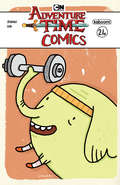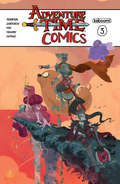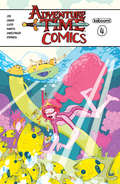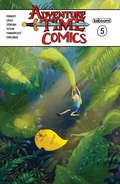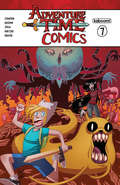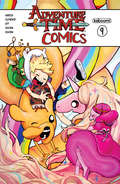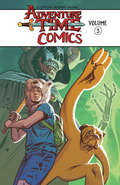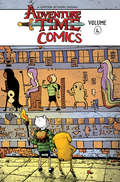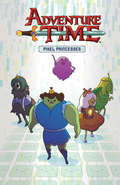- Table View
- List View
Adventure Time Comics (Adventure Time Comics #24)
by Tyler Jenkins Pendleton Ward<p>When bandits invade the Candy Kingdom and make off with a month’s supply of ice cream, it’s up to Finn and Jake to become the roughest, toughest cowboys in Ooo and rescue the stolen supplies. Written and illustrated by Grass Kings’ Tyler Jenkins! <p>This is a fixed-format ebook, which preserves the design and layout of the original print book.</p> <P><P> <i>Advisory: Bookshare has learned that this book offers only partial accessibility. We have kept it in the collection because it is useful for some of our members. Benetech is actively working on projects to improve accessibility issues such as these.</i>
Adventure Time Comics (Adventure Time Comics #25)
by Pendleton Ward<p>Finn and Jake are waiting at a bus stop, but they aren’t sure how they got there or who they are waiting for. <p>This is a fixed-format ebook, which preserves the design and layout of the original print book.</p> <P><P> <i>Advisory: Bookshare has learned that this book offers only partial accessibility. We have kept it in the collection because it is useful for some of our members. Benetech is actively working on projects to improve accessibility issues such as these.</i>
Adventure Time Comics (Adventure Time Comics #3)
by Pendleton Ward<p>This issue features three short stories headlining Detective Bubblegum, BMO, and Marceline! <p>This is a fixed-format ebook, which preserves the design and layout of the original print book.</p> <P><P> <i>Advisory: Bookshare has learned that this book offers only partial accessibility. We have kept it in the collection because it is useful for some of our members. Benetech is actively working on projects to improve accessibility issues such as these.</i>
Adventure Time Comics (Adventure Time Comics #4)
by Pendleton Ward<p>Jake keeps beating an unbeatable game, Finn's gettin' all crazy from sleep deprivation, and Jungle Princess observes the weirdos passing through her kingdom. <p>This is a fixed-format ebook, which preserves the design and layout of the original print book.</p> <P><P> <i>Advisory: Bookshare has learned that this book offers only partial accessibility. We have kept it in the collection because it is useful for some of our members. Benetech is actively working on projects to improve accessibility issues such as these.</i>
Adventure Time Comics (Adventure Time Comics #5)
by Pendleton Ward<p>Ice King goes on a Wizard's Quest to gain ultimate power, Cake tries to make Fionna a special present, and Finn gets a new pet that is really uncool. <p>This is a fixed-format ebook, which preserves the design and layout of the original print book.</p> <P><P> <i>Advisory: Bookshare has learned that this book offers only partial accessibility. We have kept it in the collection because it is useful for some of our members. Benetech is actively working on projects to improve accessibility issues such as these.</i>
Adventure Time Comics (Adventure Time Comics #6)
by Jack Sjogren Matt Frank Sonny Liew Adam GorhamWHAT CAN OOO DO? Strange peril strikes the beloved world of Ooo again and no citizen is safe! Between Ice King’s heart calling it quits, to the entire Breakfast Kingdom getting locked out of their homes when Finn and Jake drop the key to the city in the Cappuccino River, mystery and chaos ensue in this ADVENTURE TIME COMICS collection. Featuring work by Sonny Liew, Matt Frank, Cristina Rose Chua, Jack Sjogren and many more! <P><P> <i>Advisory: Bookshare has learned that this book offers only partial accessibility. We have kept it in the collection because it is useful for some of our members. Benetech is actively working on projects to improve accessibility issues such as these.</i>
Adventure Time Comics (Adventure Time Comics #6)
by Pendleton Ward<p>Gunther tells his favorite story, and Finn and Jake have to fight monsters. <p>This is a fixed-format ebook, which preserves the design and layout of the original print book.</p> <P><P> <i>Advisory: Bookshare has learned that this book offers only partial accessibility. We have kept it in the collection because it is useful for some of our members. Benetech is actively working on projects to improve accessibility issues such as these.</i>
Adventure Time Comics (Adventure Time Comics #7)
by Pendleton Ward<p>Gunter tells us his favorite story, Choose Goose gets some sweet kicks, and Finn needs to find out what's wrong with Jake's diet! <p>This is a fixed-format ebook, which preserves the design and layout of the original print book.</p> <P><P> <i>Advisory: Bookshare has learned that this book offers only partial accessibility. We have kept it in the collection because it is useful for some of our members. Benetech is actively working on projects to improve accessibility issues such as these.</i>
Adventure Time Comics (Adventure Time Comics #8)
by Pendleton Ward<p>It's a special Fionna and Cake issue by New York Times bestseller Mariko Tamaki (This One Summer)! Marshall Lee and LSP need to figure out Marshall Lee's musical identity. <p>This is a fixed-format ebook, which preserves the design and layout of the original print book.</p> <P><P> <i>Advisory: Bookshare has learned that this book offers only partial accessibility. We have kept it in the collection because it is useful for some of our members. Benetech is actively working on projects to improve accessibility issues such as these.</i>
Adventure Time Comics (Adventure Time Comics #9)
by Pendleton Ward<p>In this issue's short stories, Choose Goose is the worst, Princess Bubblegum just wants to have a nice picnic, and Ooo is definitely a weird place. <p>This is a fixed-format ebook, which preserves the design and layout of the original print book.</p> <P><P> <i>Advisory: Bookshare has learned that this book offers only partial accessibility. We have kept it in the collection because it is useful for some of our members. Benetech is actively working on projects to improve accessibility issues such as these.</i>
Adventure Time Comics Volume 1 (Adventure Time Comics #1 - 4)
by Pendleton Ward<p>WHAT TIME IS IT?! It's Adventure Time Comics time! C'mon and grab your friends for this amazing collection of short stories from cartoonists all over the world. Featuring the amazing talent of Katie Cook (My Little Pony), Art Baltazar (Tiny Titans), Tony Millionaire (Maakies and the Sock Monkey), Box Brown (Andre the Giant) and many, many more. These sweet shorts come in many shapes and sizes, featuring all of the beloved characters from the Land of Ooo. Collects issues #1-4 of the new ongoing series. <p>This is a fixed-format ebook, which preserves the design and layout of the original print book.</p> <P><P> <i>Advisory: Bookshare has learned that this book offers only partial accessibility. We have kept it in the collection because it is useful for some of our members. Benetech is actively working on projects to improve accessibility issues such as these.</i>
Adventure Time Comics Volume 2 (Adventure Time Comics #5 - 8)
by Pendleton Ward<p>It's Adventure Time Comics time! These sweet shorts come in many shapes and sizes, featuring all of the beloved characters from the Land of Ooo, written and illustrated by acclaimed cartoonists and storytellers from all over the world. Presented in the artist's own style, each story captures the creativity that Adventure Time inspires! Featuring work by Derek Fridolfs (Study Hall of Justice), Zachary Sterling (Adventure Time), Riley Rossmo (Batman), Kyla Vanderklugt (Storyteller: Witches), Roger Langridge (The Baker Street Peculiars, Snarked), and many more! Collects issues #5-8 <p>This is a fixed-format ebook, which preserves the design and layout of the original print book.</p> <P><P> <i>Advisory: Bookshare has learned that this book offers only partial accessibility. We have kept it in the collection because it is useful for some of our members. Benetech is actively working on projects to improve accessibility issues such as these.</i>
Adventure Time Comics Volume 3 (Adventure Time Comics #9 - 12)
by Pendleton Ward<p>It's ADVENTURE TIME COMICS time! These sweet shorts come in many shapes and sizes, featuring all of the beloved characters from the Land of Ooo, written and illustrated by acclaimed cartoonists and storytellers from all over the world. These stories are in the artist's own style and capture the creativity that ADVENTURE TIME inspires! Featuring work by Jorge Corona (Feathers, We Are Robin), Cole Ott (Dare House), Eva Cabrera (Kim & Kim) and many more! Collects issues #9-12. <p>This is a fixed-format ebook, which preserves the design and layout of the original print book.</p> <P><P> <i>Advisory: Bookshare has learned that this book offers only partial accessibility. We have kept it in the collection because it is useful for some of our members. Benetech is actively working on projects to improve accessibility issues such as these.</i>
Adventure Time Comics Volume 4 (Adventure Time Comics #13 - 16)
by Phillip Kennedy Johnson<p>Dive into mathematical shorts from across the the Land of Ooo, written and illustrated by acclaimed writers and artists from around the world. Collects issues #13-16. <p>This is a fixed-format ebook, which preserves the design and layout of the original print book.</p> <P><P> <i>Advisory: Bookshare has learned that this book offers only partial accessibility. We have kept it in the collection because it is useful for some of our members. Benetech is actively working on projects to improve accessibility issues such as these.</i>
Adventure Time Comics Volume 5 (Adventure Time Comics #17 - 20)
by Pendleton Ward<p>Don’t miss out on this fun collection of stories based off of Cartoon Network’s hit show ADVENTURE TIME, featuring work by Jeffrey Brown (Darth Vader and Son), Michael Moreci (Superman), Christopher Mitten (American Vampire) and many more! Collects issues #17-20. <p>This is a fixed-format ebook, which preserves the design and layout of the original print book.</p> <P><P> <i>Advisory: Bookshare has learned that this book offers only partial accessibility. We have kept it in the collection because it is useful for some of our members. Benetech is actively working on projects to improve accessibility issues such as these.</i>
Adventure Time Crafts
by Cartoon Network Chelsea BloxsomWith Jake the dog and Finn the human, the crafts will never end! Learn how to stitch, paint, sculpt, and crochet more than 23 projects featuring your favorite Adventure TimeTM characters. You'll find designs by fans just like you for plush toys, chic jewelry, crafty home decor, and stylish fashions straight from the Candy Kingdom:* Reversible Jake/Cake Plush* Marceline's Axe* Bubblegum's Like-Like Sweater* Peppermint Butler Pillow* Oh My Glob, Nail Art!* Fionna and Finn Hats* BMO's 8-Bit Fuse Bead CoastersAnd so much more! What the lump are you waiting for? It's time to D.I.Y.!
Adventure Time Mad Libs
by Roger Price Leonard SternFill in the blanks with Finn and Jake! Adventure Time Mad Libs is based on the popular Cartoon Network show starring Finn, a silly kid with an awesome hat, and his dog Jake! Our book features 21 hilarious stories set in the mystical Land of Ooo that are sure to keep you laughing!
Adventure Time Original Graphic Novel: Bitter Sweets (Planet of the Apes #4)
by Pendleton Ward Kate Leth Zachary Sterling<p>It's that lovely time of year where Princess Bubblegum gets to leave the Candy Kingdom and venture out into the outer limits of Ooo. But when her annual quest to visit old friends takes a dark and unexpected turn, it's up to PB and Peppermint Butler to keep the peace by using the true power of friendship. <p>This is a fixed-format ebook, which preserves the design and layout of the original print book.</p> <P><P> <i>Advisory: Bookshare has learned that this book offers only partial accessibility. We have kept it in the collection because it is useful for some of our members. Benetech is actively working on projects to improve accessibility issues such as these.</i>
Adventure Time Original Graphic Novel: Brain Robbers (Planet of the Apes #9)
by Pendleton Ward Josh Trujillo Philip Murphy Zachary Sterling<p>In this new original graphic novel adventure from Josh Trujillo (Love Machines) and Zachary Sterling (Adventure Time), it's the most important moment of Lumpy Space Princess's life, and it's all going to slip through her fingers if she doesn't get help. Tree Trunks comes out of her mystery-filled retirement for one last job as she agrees to help LSP on a wild west treasure hunt. Finn and Jake secretly follow along to protect their friends but discover that LSP knows more than she is letting on about this particular treasure. <p>This is a fixed-format ebook, which preserves the design and layout of the original print book.</p> <P><P> <i>Advisory: Bookshare has learned that this book offers only partial accessibility. We have kept it in the collection because it is useful for some of our members. Benetech is actively working on projects to improve accessibility issues such as these.</i>
Adventure Time Original Graphic Novel: Four Castles (Planet of the Apes #7)
by Pendleton Ward Josh Trujillo Philip Murphy Zachary Sterling<p>Not everyone appreciates flash backs as much as the rest of us but when it comes to a throw-back reunion in the Lumpy Space Kingdom, LSP is definitely not ready. With help from a very unlikely source, LSP must face the past head on! <p>This is a fixed-format ebook, which preserves the design and layout of the original print book.</p> <P><P> <i>Advisory: Bookshare has learned that this book offers only partial accessibility. We have kept it in the collection because it is useful for some of our members. Benetech is actively working on projects to improve accessibility issues such as these.</i>
Adventure Time Original Graphic Novel: Graybles, Schmaybles (Planet of the Apes #5)
by Pendleton Ward Danielle Corsetto Bridget Underwood<p>Finn and Jake are about to go on their craziest series of adventures yet...and they don't even have to leave their living room? After helping Party God with his technical issues, these two best pals discover a tiny cube all by its lonesome in the middle of the woods. Not ones to leave the helpless so...helpless, Finn and Jake take their new friend back to the treehouse and discover that some of the most harmless looking things can be the most dangerous. <p>This is a fixed-format ebook, which preserves the design and layout of the original print book.</p> <P><P> <i>Advisory: Bookshare has learned that this book offers only partial accessibility. We have kept it in the collection because it is useful for some of our members. Benetech is actively working on projects to improve accessibility issues such as these.</i>
Adventure Time Original Graphic Novel: Islands (Planet of the Apes)
by Pendleton Ward Ashly Burch Diigii DagunaTies into the huge Adventure Time: Islands television event, the mini-series airing on Cartoon Network this winter where Finn meets other humans and an important member of his family for the first time. Written by Islands show writer Ashly Burch, this story serves as a prequel to the television event. In the wake of the mushroom war and the vampire infestation, the remaining humans of Ooo have set sail for safer shores. Bunny Girl (aka Jo), who was Marceline's precocious young friend from the "Stakes" mini-series, is fearful of what dangers await them. Two <p>Bread Tom, her caretaker in Marcy's absence, does his best to assuage her concerns. But after an attack from a swarm of monstrous sea creatures almost sinks the ship, Jo and the rest of the humans start to fear that it may not be safe anywhere. Luckily, they soon reach a plentiful island populated by another gregarious group of humans and attempt to build a new colony. The humans from Ooo are delighted and finally allow themselves to relax, all except for Jo, whose paranoia is as potent as ever. Her fears are confirmed when a swarm of enormous falcons descend on the settlement and snatch Jo up for dinner. Separated from her tribe, she must brave the dangers of the wild to get back to Two Bread Tom and the rest of the humans, and maybe learn a sense of self-reliance along the way. <p>This is a fixed-format ebook, which preserves the design and layout of the original print book.</p> <P><P> <i>Advisory: Bookshare has learned that this book offers only partial accessibility. We have kept it in the collection because it is useful for some of our members. Benetech is actively working on projects to improve accessibility issues such as these.</i>
Adventure Time Original Graphic Novel: Masked Mayhem (Planet of the Apes #6)
by Pendleton Ward Kate Leth Bridget Underwood<p>In this sixth Adventure Time original graphic novel, BMO and Jake are getting ready for the biggest costume party ever- they've received invites from everyone! As they party-hop, they realize that each party has one thing in common: a prankster. Detective BMO is on the case with the help of Jake, his sidekick, to figure out what's going on. Join them as they travel all across Ooo to find who the culprit is, while still enjoying some fun times with friends. <p>This is a fixed-format ebook, which preserves the design and layout of the original print book.</p> <P><P> <i>Advisory: Bookshare has learned that this book offers only partial accessibility. We have kept it in the collection because it is useful for some of our members. Benetech is actively working on projects to improve accessibility issues such as these.</i>
Adventure Time Original Graphic Novel: Pixel Princesses (Planet of the Apes #2)
by Pendleton Ward Danielle Corsetto Zachary Sterling<p>AN ALL-NEW ADVENTURE TIME ORIGINAL GRAPHIC NOVEL! Princess gatherings aren't always tea parties and doilies, there is a lot more to being a Princess that one might think. Danielle Corsetto (GIRLS WITH SLINGSHOTS) and Zack Sterling return with an adventure where some of our favorite princesses learn what it really takes to be a princess, while learning to respect each other for their unique outlooks on life. <p>This is a fixed-format ebook, which preserves the design and layout of the original print book.</p> <P><P> <i>Advisory: Bookshare has learned that this book offers only partial accessibility. We have kept it in the collection because it is useful for some of our members. Benetech is actively working on projects to improve accessibility issues such as these.</i>
Adventure Time Original Graphic Novel: Playing With Fire (Planet of the Apes #1)
by Pendleton Ward Danielle Corsetto Zachary Sterling<p>AN ALL-NEW ADVENTURE TIME ORIGINAL GRAPHIC NOVEL! Join Flame Princess, alongside Finn and Jake, as she leaves the Flame Kingdom and goes on her very first adventure! Written by acclaimed cartoonist Danielle Corsetto (GIRLS WITH SLINGSHOTS) and drawn by rising star Zack Sterling (BRAVEST WARRIORS, ADVENTURE TIME). A black and white edition appealing to fans of SCOTT PILGRIM and Japanese manga! <p>This is a fixed-format ebook, which preserves the design and layout of the original print book.</p> <P><P> <i>Advisory: Bookshare has learned that this book offers only partial accessibility. We have kept it in the collection because it is useful for some of our members. Benetech is actively working on projects to improve accessibility issues such as these.</i>
